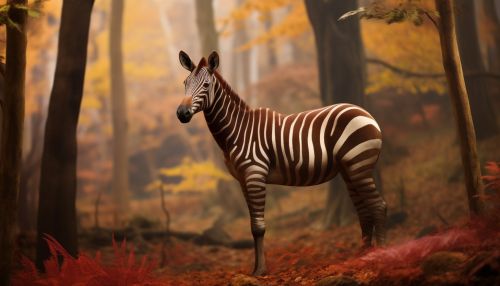Okapi
Taxonomy and Evolution
The Okapi (Okapia johnstoni) is a mammal native to the Democratic Republic of the Congo in Central Africa. Although the Okapi bears striped markings reminiscent of zebras, it is most closely related to the giraffe. The species was first described by British explorer Harry Johnston in 1901, a relatively late discovery in terms of large mammalian taxonomy. The genus name Okapia derives from the Lese Karo name o'api, while the species name johnstoni is in recognition of Johnston, who first acquired an okapi specimen for science from the Ituri Forest.
The okapi and the giraffe are the only living members of the family Giraffidae. The family was once more extensive, with over 20 fossil genera described. Although okapi and giraffe are the only extant members, the okapi shows more primitive characteristics, like a shorter neck and a small hump, similar to extinct giraffids.


Description and Anatomy
Okapis have dark bodies, with striking horizontal white stripes on the back legs, making them resemble zebras. These markings possibly help young follow their mothers through the dense rain forest and may also serve as camouflage. The body shape is similar to that of the giraffe, except okapis have much shorter necks. Both species have very long (14–18 in or 36–46 cm), flexible, blue tongues that they use to strip leaves and buds from trees. The tongue of the okapi is long enough for the animal to wash its eyelids and clean its ears: it is one of the few mammals that can lick its own ears.
Male okapis have short, skin-covered horns called ossicones. They have large ears, which help them detect their predator, the leopard. Okapis are 1.9 to 2.5 m (6.2 to 8.2 ft) long from the head to the base of the tail, and the tail adds 30 to 42 cm (12 to 17 in). They stand from 1.5 to 2.0 m (4.9 to 6.6 ft) high at the shoulder. Their weight ranges from 200 to 350 kg (440 to 770 lb).
Habitat and Distribution
Okapis are primarily diurnal and essentially solitary, coming together only to breed. They are native to the tropical rainforests of the Democratic Republic of the Congo, where they inhabit the canopy, or the upper layer of the forest. They are most commonly found in the Ituri Rainforest, a dense and humid environment characterized by a rich biodiversity. The okapi's distribution is limited by high montane forests to the east and savannas to the south and west. The range is thus confined to a long, narrow stretch of land running from the Maiko National Park in the south to the Nepoko River in the north.
Diet
Okapis are herbivores, feeding on tree leaves and buds, grasses, ferns, fruits, and fungi. Many of the plant species fed upon by the okapi are poisonous to humans. To reach high branches, okapis have a similar action to giraffes, bending the base of the leafy branch with the flexible upper lip and tongue, then stripping the leaves off the bent branch. They have a low metabolic rate for mammals of their size, which allows them to survive on relatively little food.
Reproduction and Lifecycle
Okapis are sexually dimorphic, with females slightly larger and taller than males. The estrous cycle lasts 15 days, and the female signals her readiness to mate by urinating. Gestation lasts from 440 to 450 days, after which usually a single calf is born, although twins occasionally occur. The young are nursed and cared for by their mothers, a period during which the mother leaves the infant concealed while foraging for her own food. Young okapis become independent at about one year of age.
Conservation Status
The okapi is classified as endangered on the IUCN Red List. Major threats include habitat loss due to logging and human settlement. Extensive hunting for bushmeat and skin and illegal mining have also led to a decline in populations. The Okapi Conservation Project was established in 1987 to protect okapi populations.
Cultural Significance
In the Congo, the okapi is revered and protected by local taboos and is seen as a symbol of the nation. The animal is a national symbol and is included in the logo of the Institut Congolais pour la Conservation de la Nature. It has been depicted on postage stamps and was the namesake of the Okapi Wildlife Reserve.
